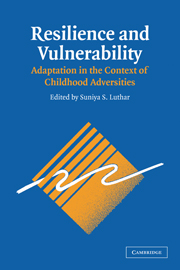Book contents
- Frontmatter
- Contents
- List of Contributors
- Foreword by Dante Cicchetti
- Preface
- 1 A Resilience Framework for Research, Policy, and Practice
- PART I FAMILIAL ADVERSITIES: PARENTAL PSYCHOPATHOLOGY AND FAMILY PROCESSES
- 2 Young Children with Mentally Ill Parents: Resilient Developmental Systems
- 3 Risk and Protective Factors for Children of Depressed Parents
- 4 Resilience and Vulnerability among Sons of Alcoholics: Relationship to Developmental Outcomes between Early Childhood and Adolescence
- 5 Maternal Drug Abuse versus Other Psychological Disturbances: Risks and Resilience among Children
- 6 Resilience to Childhood Adversity: Results of a 21-Year Study
- 7 Sequelae of Child Maltreatment: Vulnerability and Resilience
- 8 Risk and Resilience in Children Coping with Their Parents' Divorce and Remarriage
- 9 Correlational and Experimental Study of Resilience in Children of Divorce and Parentally Bereaved Children
- PART II EXOSYSTEMIC AND SOCIODEMOGRAPHIC RISKS
- PART III COMMENTARIES
- Index
- References
3 - Risk and Protective Factors for Children of Depressed Parents
Published online by Cambridge University Press: 05 June 2012
- Frontmatter
- Contents
- List of Contributors
- Foreword by Dante Cicchetti
- Preface
- 1 A Resilience Framework for Research, Policy, and Practice
- PART I FAMILIAL ADVERSITIES: PARENTAL PSYCHOPATHOLOGY AND FAMILY PROCESSES
- 2 Young Children with Mentally Ill Parents: Resilient Developmental Systems
- 3 Risk and Protective Factors for Children of Depressed Parents
- 4 Resilience and Vulnerability among Sons of Alcoholics: Relationship to Developmental Outcomes between Early Childhood and Adolescence
- 5 Maternal Drug Abuse versus Other Psychological Disturbances: Risks and Resilience among Children
- 6 Resilience to Childhood Adversity: Results of a 21-Year Study
- 7 Sequelae of Child Maltreatment: Vulnerability and Resilience
- 8 Risk and Resilience in Children Coping with Their Parents' Divorce and Remarriage
- 9 Correlational and Experimental Study of Resilience in Children of Divorce and Parentally Bereaved Children
- PART II EXOSYSTEMIC AND SOCIODEMOGRAPHIC RISKS
- PART III COMMENTARIES
- Index
- References
Summary
It is now well established that depression runs in families and that maternal depression may be associated with a variety of maladaptive outcomes in children. Because of the high frequency of depression worldwide – especially among women of child-bearing age (e.g., Weissman & Olfson, 1995), this is a high-risk problem of considerable magnitude, and one with the potential for transmission through multiple generations. The topic of resilience, however, has been relatively neglected despite the fact that many, if not most, offspring of depressed parents do not apparently suffer major negative consequences – and despite the potential yield of preventive interventions for children at risk. This chapter will explore the contribution of the mood disorders field to resilience research, following a brief analysis of the depression high-risk research and a discussion of risk and protective factors and mechanisms. Finally, implications and directions for future research and intervention will be presented.
NEGATIVE OUTCOMES OF CHILDREN OF DEPRESSED PARENTS
There has been considerable research in the past 15–20 years that demonstrates the negative consequences of parental depression for children. Despite the solid empirical base establishing risk to children, remarkably little research has answered, or even explored, many key questions concerning the phenomena and the mechanisms, much less issues concerning resilience. Heterogeneity in many of the key constructs is one important source of the limited conclusions to date, and therefore several definitional problems are noted prior to a summary of the research on children's outcomes.
- Type
- Chapter
- Information
- Resilience and VulnerabilityAdaptation in the Context of Childhood Adversities, pp. 50 - 75Publisher: Cambridge University PressPrint publication year: 2003
References
- 22
- Cited by



